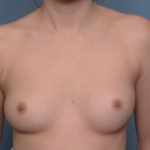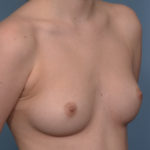Background: There are four access incisions in which to place breast implants. (inframammary, areolar, axillary and umbilical) Each has their own advantages and disadvantages as well as surgical advocates and opponents. Such a varied number of approaches indicates that neither one is perfect and each can potentially work well with good technique.
The axillary or transaxillary approach has beeb around as long as saline breast implants have been used. This is what it was originally made for as saline implants are inserted in a rolled and deflated fashion. Thus very small skin incisions can be used high up in the armpit. It also provides the most direct and shortest distance into the subpectoral plane. Between the ‘hidden’ scar and the infallible access under the muscle, these are its two greatest assets.
It was originally done in a blinded blunt pocket dissection and has evolved more recently using a visually guided endoscopic technique. There are surgeons who use both methods successfully. I have used the blunt dissection method for over 25 years in over 500 cases and have not found the endoscopic technique to be an advantage for me. But for those who use it the direct visual access to the inferomedial muscle release is comforting.
One issue with the transaxillary breast implant placement method is that the high and complete pocket dissection results in greater upper pole fullness in the early recovery period. While all breast implant placement methods result in upper pole and a need for implant settling, the transaxillary approach magnifies that short term effect. This is due to the greater amount if tissue trauma that occurs coming in from such a superior point of access.
Case Study: This young female had B cup breasts that were widely spaced. She wanted to be enlarged to a fuller C cup. She desired silicone implants due to a desire for a more natural feel. She wanted them placed through axillary incisions to keep here breasts scar free.


Case Highlights:
1) The transaxillary approach for breast augmentation is an effective technique that has been enhanced with the use of the funnel insertion device.
2) Up to 500cc silicone implants can be placed through an axillary incision although it will be longer than that used for saline breast implants.
3) The high point of implant insertion usually results in a longer time for implant settling.
Dr. Barry Eppley
Indianapolis, Indiana




